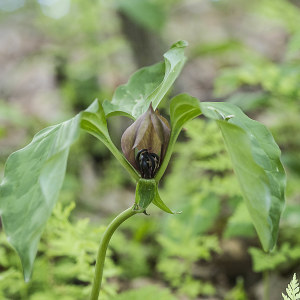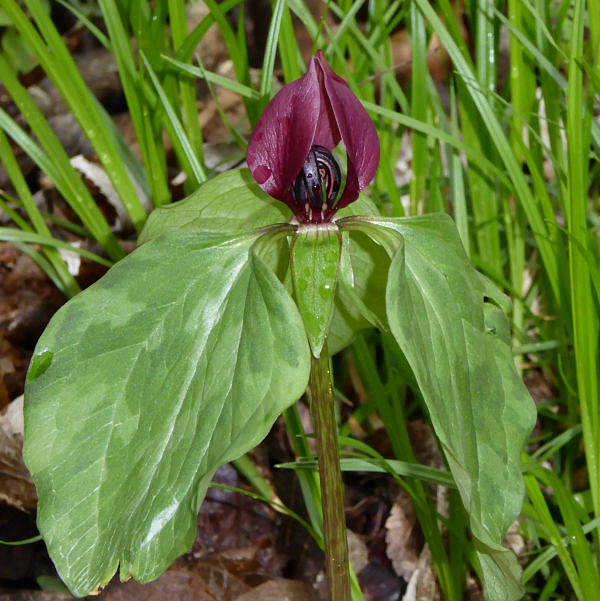Lora Conrad shares spectacular photographs of a hard-to-find spring wildflower. -promoted by Laura Belin
The first spring you spot one in bloom, you will be spellbound. A strange but enthralling flower with sepals down and petals up in an unlikely maroon or wine-red color atop three mottled leaves on a single skinny scape perhaps a foot high. You’ve just found a Trillium recurvatum!
THE NAMING
Trillum recurvatum is the only name unique to this plant. It’s often called the prairie trillium, especially in the Midwest, despite the fact that it grows in the woods. It’s also called the purple trillium, bloody butcher (not a very kindly name for such an interesting flower), wood lily, and about half a dozen other names, some of which are also applied to other trilliums. Thus the use of common names can be confusing.
True to its trillium name (derived from the Latin trilix meaning triple and Latin lillium for lily), when blooming, it has three evenly-spaced leaves mottled with purple or shades of green with an erect, sessile flower with three petals at the center curved inward, with three sepals turned down and an ovary with three stigmata (but six stamens). The epithet recurvatum refers to the three sepals that are curved backward –one of the key identifiers of this plant.
ORIGIN
Trillium recurvatum is just one of 39 native trilliums in the United States but only five are recorded for Iowa in the NRCS database. Trillium recurvatum is native to Iowa and sixteen states south or east of Iowa. However, there is no county by county data for Iowa reported to the NRCS database. It is listed as endangered in at least one state, Michigan, and threatened in others. (plants.usda.gov)
FINDING IT
You will find it blooming in Iowa in April and May. It blooms much later than the small snow trillium, usually after Dutchman’s breeches but with wild ginger (which has a flower of similar color). Look for it in partial to full shade where it is often found on rocky slopes or in bottom lands in undisturbed areas in deciduous woodlands. Frequently there will be a variety of sizes (ages) of plants in a small area where they have developed from the rhizomes or come up from seeds. These will vary from very young plants that are only a single leaf as shown here.
Then slightly older plants will be short, 2 to 6 inches, with no blossom, just the three leaves, as shown here.
When they are mature and strong enough to bloom, which may take five to seven years, an erect single green bud as shown below forms in the apex of the three leaves.
As it begins to open, the sepals will not be turned down at first, nor the petals curved inward, as shown here.
When the flower completes opening, it will look like this.
The individual flower can last longer than most other spring flowers. The flower has very little aroma, though some consider the smell unpleasant. The flower may be followed by a seed pod of about a half-inch with several small seeds inside. The stem is more accurately called a scape, since it grows from the bulb. There will be one single scape, usually green at the top and more reddish purple lower on the scape.
Over about a month, the blossom and the leaves will fade as shown here: 
Then some will form seed pods. By mid-summer, the plant will have finished its work and died, not to appear again until the following spring.
CULTURE
Trillium recurvatum grows in the same conditions as trout lily or Dutchman’s breeches — moist soil in wooded areas. As a member of the Liliaceae or Lily family, it spreads slowly from the rhizomes. It is difficult to transplant. Trillium should not be dug from the wild, but enjoyed where it grows.
The seed are distributed by deer and ants, but the seeds can take as much as two years to send a leaf above the ground. After some time in the ground “conditioning,” a seed sprouts a root underground which grows for about a year before sending up a single leaf. Sadly, if the deer browse down too many of any age, they can kill out a local population, as after they are cut they will not regrow until the next year, if then. Left undisturbed, and not consumed by deer, trillium plants have been determined to be as much as 25 to 50 years of age.
USES
Young Trillium leaves of many types are edible but the roots and seed pods are mildly toxic. However, they have been used in alternative medicines for many years as well as used as an herb by Native American tribes. The root is antiseptic, antispasmodic, diuretic, emmenagogue, and ophthalmic. For more information, see the Alternative Nature Online Herbal website.
VARIATIONS AND SIMILAR TRILLIUMS
Though all Trillium recurvatum the author has seen in Iowa are various shades of maroon, there are yellow flowered ones with black or purple anthers documented in Missouri which are known as Trillium recurvatum f. luteum. There is also a very rare green to yellowish flowering variation with yellow anthers (not seen by the author), documented in Illinois and known as Trillium recurvatum shayii or Shay’s Trillium.
Similar trilliums are Trillium sessile (called Toadshade) and Trillium cuneatum (called Sweet Betsy). These have not been reported to the NRCS database as being found in Iowa. [Editor’s note from Laura Belin: I think I have seen Toadshade trillium in several locations.]
However, only Trillium recurvatum has the 3 reflexed (curved down) sepals and the inward curved petals and stamens.
Enjoy them all! Please do not remove any from the locations where they are found.










1 Comment
Beautiful photos of a beautiful flower, thank you...
…and the part about deer is all too appropriate. Currently, Iowa deer population policies are determined by the Iowa Legislature as well as the DNR, and those policies are based on money and political clout, not ecological health. The “acceptable” deer population density in Iowa urban/suburban areas is about 35 deer per square mile, which is far too high.
Below is an excerpt from a 2014 study. It’s a good bet that deer in Iowa are no less fond of trilliums. Deer also especially like lilies and orchids.
***
The results of this study demonstrate that Trillium species growing in the lands of the Indiana Dunes National Lakeshore are being suppressed reproductively by deer browsing…Responses of plants to protection from deer suggest that deer culling might be necessary for 6 or more years for red trillium populations and rare trillium species to recover.
PrairieFan Wed 15 May 10:23 PM